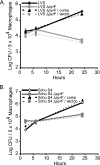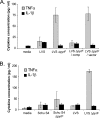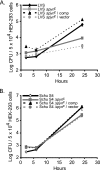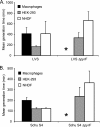Francisella tularensis DeltapyrF mutants show that replication in nonmacrophages is sufficient for pathogenesis in vivo
- PMID: 20385757
- PMCID: PMC2876533
- DOI: 10.1128/IAI.00134-10
Francisella tularensis DeltapyrF mutants show that replication in nonmacrophages is sufficient for pathogenesis in vivo
Abstract
The pathogenesis of Francisella tularensis has been associated with this bacterium's ability to replicate within macrophages. F. tularensis can also invade and replicate in a variety of nonphagocytic host cells, including lung and kidney epithelial cells and hepatocytes. As uracil biosynthesis is a central metabolic pathway usually necessary for pathogens, we characterized DeltapyrF mutants of both F. tularensis LVS and Schu S4 to investigate the role of these mutants in intracellular growth. As expected, these mutant strains were deficient in de novo pyrimidine biosynthesis and were resistant to 5-fluoroorotic acid, which is converted to a toxic product by functional PyrF. The F. tularensis DeltapyrF mutants could not replicate in primary human macrophages. The inability to replicate in macrophages suggested that the F. tularensis DeltapyrF strains would be attenuated in animal infection models. Surprisingly, these mutants retained virulence during infection of chicken embryos and in the murine model of pneumonic tularemia. We hypothesized that the F. tularensis DeltapyrF strains may replicate in cells other than macrophages to account for their virulence. In support of this, F. tularensis DeltapyrF mutants replicated in HEK-293 cells and normal human fibroblasts in vitro. Moreover, immunofluorescence microscopy showed abundant staining of wild-type and mutant bacteria in nonmacrophage cells in the lungs of infected mice. These findings indicate that replication in nonmacrophages contributes to the pathogenesis of F. tularensis.
Figures












Similar articles
-
Impact of Francisella tularensis pilin homologs on pilus formation and virulence.Microb Pathog. 2011 Sep;51(3):110-20. doi: 10.1016/j.micpath.2011.05.001. Epub 2011 May 13. Microb Pathog. 2011. PMID: 21605655 Free PMC article.
-
A Francisella tularensis locus required for spermine responsiveness is necessary for virulence.Infect Immun. 2011 Sep;79(9):3665-76. doi: 10.1128/IAI.00135-11. Epub 2011 Jun 13. Infect Immun. 2011. PMID: 21670171 Free PMC article.
-
Interactions of Francisella tularensis with Alveolar Type II Epithelial Cells and the Murine Respiratory Epithelium.PLoS One. 2015 May 26;10(5):e0127458. doi: 10.1371/journal.pone.0127458. eCollection 2015. PLoS One. 2015. PMID: 26010977 Free PMC article.
-
Uncovering the components of the Francisella tularensis virulence stealth strategy.Front Cell Infect Microbiol. 2014 Mar 7;4:32. doi: 10.3389/fcimb.2014.00032. eCollection 2014. Front Cell Infect Microbiol. 2014. PMID: 24639953 Free PMC article. Review.
-
Programmed cell death and the pathogenesis of tissue injury induced by type A Francisella tularensis.FEMS Microbiol Lett. 2009 Nov;301(1):1-11. doi: 10.1111/j.1574-6968.2009.01791.x. Epub 2009 Sep 17. FEMS Microbiol Lett. 2009. PMID: 19811540 Free PMC article. Review.
Cited by
-
Insertional mutagenesis in the zoonotic pathogen Chlamydia caviae.PLoS One. 2019 Nov 7;14(11):e0224324. doi: 10.1371/journal.pone.0224324. eCollection 2019. PLoS One. 2019. PMID: 31697687 Free PMC article.
-
IglC and PdpA are important for promoting Francisella invasion and intracellular growth in epithelial cells.PLoS One. 2014 Aug 12;9(8):e104881. doi: 10.1371/journal.pone.0104881. eCollection 2014. PLoS One. 2014. PMID: 25115488 Free PMC article.
-
Low dose vaccination with attenuated Francisella tularensis strain SchuS4 mutants protects against tularemia independent of the route of vaccination.PLoS One. 2012;7(5):e37752. doi: 10.1371/journal.pone.0037752. Epub 2012 May 25. PLoS One. 2012. PMID: 22662210 Free PMC article.
-
The use of resazurin as a novel antimicrobial agent against Francisella tularensis.Front Cell Infect Microbiol. 2013 Dec 6;3:93. doi: 10.3389/fcimb.2013.00093. eCollection 2013. Front Cell Infect Microbiol. 2013. PMID: 24367766 Free PMC article.
-
The orange spotted cockroach (Blaptica dubia, Serville 1839) is a permissive experimental host for Francisella tularensis.Proc W Va Acad Sci. 2017;89(3):34-47. Epub 2017 Dec 4. Proc W Va Acad Sci. 2017. PMID: 29578544 Free PMC article.
References
-
- Abril, C., H. Nimmervoll, P. Pilo, I. Brodard, B. Korczak, S. Markus, R. Miserez, and J. Frey. 2008. Rapid diagnosis and quantification of Francisella tularensis in organs of naturally infected common squirrel monkeys (Saimiri sciureus). Vet. Microbiol. 127:203-208. - PubMed
-
- Barker, J. R., and K. E. Klose. 2007. Molecular and genetic basis of pathogenesis in Francisella tularensis. Ann. N. Y. Acad. Sci. 1105:138-159. - PubMed
-
- Boeke, J. D., F. LaCroute, and G. R. Fink. 1984. A positive selection for mutants lacking orotidine-5′-phosphate decarboxylase activity in yeast: 5-fluoro-orotic acid resistance. Mol. Gen. Genet. 197:345-346. - PubMed
Publication types
MeSH terms
Substances
Grants and funding
LinkOut - more resources
Full Text Sources
Other Literature Sources
Research Materials
Miscellaneous

